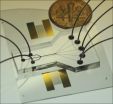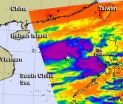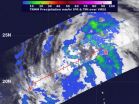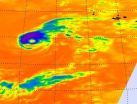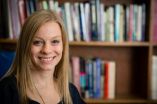(Press-News.org) UNIVERSITY PARK, Pa. -- A technique that uses acoustic waves to sort cells on a chip may create miniature medical analytic devices that could make Star Trek's tricorder seem a bit bulky in comparison, according to a team of researchers.
The device uses two beams of acoustic -- or sound -- waves to act as acoustic tweezers and sort a continuous flow of cells on a dime-sized chip, said Tony Jun Huang, associate professor of engineering science and mechanics, Penn State. By changing the frequency of the acoustic waves, researchers can easily alter the paths of the cells.
Huang said that since the device can sort cells into five or more channels, it will allow more cell types to be analyzed simultaneously, which paves the way for smaller, more efficient and less expensive analytic devices.
"Eventually, you could do analysis on a device about the size of a cell phone," said Huang. "It's very doable and we're making in-roads to that right now."
Biological, genetic and medical labs could use the device for various types of analysis, including blood and genetic testing, Huang said.
Most current cell-sorting devices allow the cells to be sorted into only two channels in one step, according to Huang. He said that another drawback of current cell-sorting devices is that cells must be encapsulated into droplets, which complicates further analysis.
"Today, cell sorting is done on bulky and very expensive devices," said Huang. "We want to minimize them so they are portable, inexpensive and can be powered by batteries."
Using sound waves for cell sorting is less likely to damage cells than current techniques, Huang added.
In addition to the inefficiency and the lack of controllability, current methods produce aerosols, gases that require extra safety precautions to handle.
The researchers, who released their findings in the current edition of Lab on a Chip, created the acoustic wave cell-sorting chip using a layer of silicone -- polydimethylsiloxane. According to Huang, two parallel transducers, which convert alternating current into acoustic waves, were placed at the sides of the chip. As the acoustic waves interfere with each other, they form pressure nodes on the chip. As cells cross the chip, they are channeled toward these pressure nodes.
The transducers are tunable, which allows researchers to adjust the frequencies and create pressure nodes on the chip.
The researchers first tested the device by sorting a stream of fluorescent polystyrene beads into three channels. Prior to turning on the transducer, the particles flowed across the chip unimpeded. Once the transducer produced the acoustic waves, the particles were separated into the channels.
Following this experiment, the researchers sorted human white blood cells that were affected by leukemia. The leukemia cells were first focused into the main channel and then separated into five channels.
The device is not limited to five channels, according to Huang.
"We can do more," Huang said. "We could do 10 channels if we want, we just used five because we thought it was impressive enough to show that the concept worked."
Huang worked with Xiaoyun Ding, graduate student, Sz-Chin Steven Lin, postdoctoral research scholar, Michael Ian Lapsley, graduate student, Xiang Guo, undergraduate student, Chung Yu Keith Chan, doctoral student, Sixing Li, doctoral student, all of the Department of Engineering Science and Mechanics at Penn State; Lin Wang, Ascent BioNano Technologies; and J. Philip McCoy, National Heart, Lung and Blood Institute, National Institutes of Health.
INFORMATION:
The National Institutes of Health Director's New Innovator Award, the National Science Foundation, Graduate Research Fellowship and
the Penn State Center for Nanoscale Science supported this work.
Acoustic cell-sorting chip may lead to cell phone-sized medical labs
2012-10-03
ELSE PRESS RELEASES FROM THIS DATE:
Payoff lacking for casino comps
2012-10-03
A study of widely used complimentary offers at Atlantic City casinos finds that common giveaways such as free rooms and dining credits are less profitable – and lead to unhealthy competition among casinos – than alternative comps such as free travel and parking.
The research, co-authored by Seul Ki Lee, an assistant professor at Temple University's School of Tourism and Hospitality Management, analyzed monthly promotional allowance and expenditure data from 11 casinos in the Atlantic City market from 2008 to 2010. Atlantic City is the second largest gaming market in ...
Study reveals differences in overall health of Latino-American subgroups
2012-10-03
TALLAHASSEE, Fla. - Despite a shared Latino heritage, there are significant differences in the overall health and the use of health-care services among Cuban-Americans, Mexican-Americans and Puerto Rican-Americans — even between men and women in the same subgroup — according to two recently published studies by Florida State University researchers.
The authors, led by College of Social Work Professor and Associate Dean Amy L. Ai, evaluated the physical and behavioral health, as well as the health care service usage, of all three major Latino subgroups in the United States. ...
Cedars-Sinai study sheds light on bone marrow stem cell therapy for pancreatic recovery
2012-10-03
LOS ANGELES (Oct. 2, 2012) – Researchers at Cedars-Sinai's Maxine Dunitz Neurosurgical Institute have found that a blood vessel-building gene boosts the ability of human bone marrow stem cells to sustain pancreatic recovery in a laboratory mouse model of insulin-dependent diabetes.
The findings, published in a PLOS ONE article of the Public Library of Science, offer new insights on mechanisms involved in regeneration of insulin-producing cells and provide new evidence that a diabetic's own bone marrow one day may be a source of treatment.
Scientists began studying ...
NASA sees strong thunderstorms in Tropical Storm Gaemi
2012-10-03
Infrared NASA satellite imagery revealed that the strongest thunderstorms within Tropical Storm Gaemi in the western North Pacific Ocean were located around the storm's center and in a band of thunderstorms east of the center.
On Oct. 2, 2012 at 1500 UTC (11 a.m. EDT) Tropical Storm Gaemi had maximum sustained winds near 40 knots (46 mph/74 kph). It was located about 515 nautical miles (592 miles/954 km) east of Hue, Vietnam, near 15.3 North latitude and 116.7 East longitude. Gaemi is moving to the southeast at 9 knots (10 mph/16.6 kph).
Infrared imagery from the AIRS ...
NASA sees heaviest rainfall in Tropical Storm Maliski's eastern side
2012-10-03
Wind shear is pushing the heaviest rainfall within Tropical Storm Maliksi east of the storm's center, and NASA's TRMM satellite captured it on Oct. 2 as it passed overhead from space.
When NASA's Tropical Rainfall Measuring Mission (TRMM) satellite passed over Tropical Storm Maliksi on Oct. 2 at 1206 UTC (8:06 a.m. EDT), the precipitation radar instrument detected light rainfall occurring over most of the storm. The heaviest rainfall was moderate was falling east of the center at a rate between .78 to 1.57 inches/20 to 40 mm per hour. There was a small area of heavy rainfall ...
Infrared NASA imagery shows Nadine still has an eye, despite being a tropical storm
2012-10-03
Forecasters know that Tropical Storm Nadine is a fighter as it continues to stay alive in the eastern Atlantic Ocean. Even satellite imagery shows Nadine's fighting spirit, because although Nadine is now a tropical storm, infrared data clearly shows that Nadine maintained an eye early on Oct. 2.
At 11 a.m. EDT on Oct. 2, Nadine remains a tropical storm and appears to be weakening. Nadine's maximum sustained winds were near 65 mph (100 kph). The center of Tropical Storm Nadine was located near latitude 34.2 north and longitude 37.5 west. Nadine is moving toward the east-southeast ...
Infertility treatments may significantly increase multiple sclerosis activity
2012-10-03
Researchers in Argentina report that women with multiple sclerosis (MS) who undergo assisted reproduction technology (ART) infertility treatment are at risk for increased disease activity. Study findings published in Annals of Neurology, a journal of the American Neurological Association and Child Neurology Society, suggest reproductive hormones contribute to regulation of immune responses in autoimmune diseases such as MS.
According to a 2006 report from the World Health Organization (WHO), MS affects 2.5 million individuals worldwide and is more common among women ...
New definition of autism in DSM-5 will not exclude most children with autism
2012-10-03
NEW YORK (Oct. 1, 2012) -- Parents should not worry that proposed changes to the medical criteria redefining a diagnosis of autism will leave their children excluded and deemed ineligible for psychiatric and medical care, says a team of researchers led by psychologists at Weill Cornell Medical College.
Their new study, published in the October 1 issue of the American Journal of Psychiatry, is the largest to date that has tried to unpack the differences between the diagnostic criteria for autism spectrum disorders in the fourth edition of the Diagnostic and Statistical ...
For some women, genes may influence pressure to be thin
2012-10-03
EAST LANSING, Mich. — Genetics may make some women more vulnerable to the pressure of being thin, a study led by Michigan State University researchers has found.
From size-zero models to airbrushed film stars, thinness is portrayed as equaling beauty across Western culture, and it's an ideal often cited as a cause of eating disorder symptoms in young women.
The researchers focused on the potential psychological impact of women buying into this perceived ideal of thinness, which they call thin-ideal internalization. Changes in self-perception and behavior, caused by ...
Chloroquine makes comeback to combat malaria
2012-10-03
Malaria-drug monitoring over the past 30 years has shown that malaria parasites develop resistance to medicine, and the first signs of resistance to the newest drugs have just been observed. At the same time, resistance monitoring at the University of Copenhagen shows that the previously efficacious drug chloroquine is once again beginning to work against malaria. In time that will ensure cheaper treatment for the world's poor.
Scientists and healthcare personnel the world over fear that the malaria parasite will develop resistance to the current frontline treatment against ...
